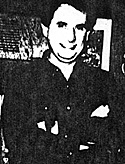Gary Comardo (Ardo), Bruce Taylor and I got together last Saturday to playtest my second revision of our new Dark Ages/Medieval tactical rules. We used armies of varied strength, Ardo bringing his 25mm Vikings against my Norse-Irish. There were approximately 250 figures per side on a 5'x 8' table with pre-set terrain and camps. Gary had never seen the rules before, but had no trouble at all getting into it (he is a big DBM fan).
 At right, Bruce 'The Bastard' Taylor and his victory stance.
At right, Bruce 'The Bastard' Taylor and his victory stance.
The Vikings were in three commands under three leaders, with such names as Ragnar the Stupid and Sigurd Squirreldick! No respect, no respect at all. Anyway, the Viking army consisted of six large bands of Norsemen (six to eight stands each), lightly-armored, average quality fighters armed with javelin, sword and shield; four smaller groups of mailed huscarls (four stands each), variously armed with axes, javelins and shields; two bands of Norsemen with bow, javelin and shield and four small (two stand) bodies of berserkers with axes and shields. Each of the leaders had a bodyguard of fully mailed household troops with axes and shields.
My Norse-Irish were organized into three divisions as well. There were three large (six to eight stand) bands of Vikings, the same quality, armor and weaponry as Ardo's. I also opted for three bands of skirmishers, one bow-armed (six stands) and two of Irish kerns, javelin and shield armed (also six stands). The rest of the Norse contingent had four mailed huscarl units, veteran quality with axes or javelins and shields; two large archer bands, average quality with bow, javelin and shield as well as two berserker bands, Fanatic quality with axes and shields.
The Irish contingent had a large warband (eight stands) of unarmored, unshielded bonnachts with axes and javelins; a body of nobles, mailed with javelin, sword and shield (four stands) and Bruce the Bold, their erstwhile leader with his mailed, household Teula guard. The two bands of kern also were under Bruce's control.
Terrain
The terrain was fairly plain, with two large woods on either flank and hills in the center near each base-line. Since the rules use a blind set up, I placed a cardboard screen across the center of the table to hide our initial dispositions. When the screen was removed, I saw that Ardo had opted to form his army close together in the center with reserves. He did place three bands of Vikings on his left as a threat to sweep past the woods and hit my camp.
I, too, had thought along the same lines, except my idea was to complete a double envelopment of Ardo's army. The Irish on the right were to sweep their enemies into Valhalla as two bands of Norse (a huscarl and a berserker) would do the same on my left. Let it be said that attempting to swing around the extreme flanks of two large woods was not the most intelligent plan in the history of warfare, but trying to go through the dense woods would have taken all day!
One thing which FOR GOD, WEALTH AND HONOR (FGWH) restricts is command control. If a warband is over 300 yards away from a leader or is lost to sight in woods, etc., it is twice as hard to control. My brilliant left flank attack bogged down as soon as the troops were barely half way around the woods.
It is intelligent to keep your leaders close to the front lines of the battle. They are limited in the number of orders which may be given each turn, and if their command is large, some bands of fighters will do nothing more than sit and watch unless of Fanatic quality or already involved in close combat. Once your leader decides to lead, i.e. join in a melee, he issues no orders at all until once again uninvolved with personal combat.
Centers Close
Ardo's center and mine closed to missile range on our first turn (usually, your troops will be into the face of the enemy on the second turn of the game...if your initial setup is poor, you have to think and act fast to rectify the situation or you will lose). Long range missile fire from moving archers is not good, rarely will a casting casualty be lost, but if you can get enough figures firing, you might get lucky.
We both managed to inflict a hit with four units each shooting! Bruce had command of the Irish and immediately went up against Ardo's Vikings, getting the worst of the initial missile exchanges. [Knowing Bruce, I am sure that was not the fault of the Norse Irish troops.-Fish].
On my left, the huscarl/berserker attack around the woods ground to a halt once out of sight of their leader. Perhaps the idea of facing three to one odds had a little to do with it. The center warbands plowed into each other without bothering to form shieldwall. The battle swayed back and forth as first one side then the other gained the tactical advantage, but finally, Ardo's Vikings took too many casualties and morale failures broke his center. He had forseen just such a problem and managed to bring up a second line of reserves to stem my bloodied pursuers. We continually found our battered warbands becoming 'mad as hell' or frenzied in the heat of combat, and losses were mounting on both sides.
Bruce's lowly bonnachts smashed through the Vikings before them but were in turn fragmented by Ardo's attacks with huscarls and berserkers. The kerns headed into the woods (the only safe place for skirmishers) and threatened the flank of Ardo's hotly pressed center.
Over
Then it was over. A mass morale failure on the part of the Vikings (it does not help to have your CiC die before the eyes of half your army) caused them to disintegrate. The Norse-Irish had gained a victory. The game took a little under three hours to play to a definite and conclusive decision.
 At right, the editor and his Welshmen.
At right, the editor and his Welshmen.
There were no 'weird' rule variances and Ardo liked the clean, easy flow of the game and the decisiveness of battle. We had a long post-game discussion and I have decided to add two more 'period feel' aspects of Dark Age/Medieval warfare. The first is the Holy man/priest/mullah/shaman character. He will cost you points, but if opting to buy a religious figure, you will be able to re-roll one die roll per turn, whether missile fire, morale or close combat.
Feeling looked out for by God, or conversely, abandoned by Him was a very real part of the psychology of medieval man. Often an impossible situation (the Crusaders at Antioch, for example) would be saved by the belief on the part of the fighters in Divine intervention. Hence this addition. [Terry what happens when the religious character? Abandonment by the divine or is he simply called to serve on a higher level? -Fish]
Adding Champions
The other new addition will be the champion, master of battle, or hero figure. Again, if opting to include a champion in one's army, he will have to be purchased. The champion may fight on his own (as a stand of figures; himself and his immediate followers), with a fanatical view of his place in the world. He will immediately attack any enemy within range and have an extreme bonus to his fighting ability. He will also die in short order if fighting alone; one stand is destroyed quickly.
If the champion begins the game as part of another warband, he will lose the fanatical "charge anybody in sight" restriction, but will add to the morale and fighting ability of the band he is with. The choice is up to the player.
The rules look and feel better in 25mm than in 15mm, but I will continue to playtest them in both sizes. As before, I had a great time, and FOR GOD, WEALTH AND HONOR (FGWH) continue to improve with each game. There is still a ways to go, but I'm having fun during the learning process. Next, Dave Ottney, one of Armati's biggest contributors will be coming over. We'll see how he likes them....
Back to Saga #57 Table of Contents
© Copyright 1997 by Terry Gore
This article appears in MagWeb (Magazine Web) on the Internet World Wide Web.
Other military history articles and gaming articles are available at http://www.magweb.com